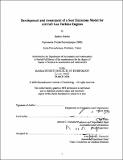Development and assessment of a soot emissions model for aircraft gas turbine engines
Author(s)
Martini, Bastien
DownloadFull printable version (20.99Mb)
Other Contributors
Massachusetts Institute of Technology. Dept. of Aeronautics and Astronautics.
Advisor
Ian Waitz.
Terms of use
Metadata
Show full item recordAbstract
Assessing candidate policies designed to address the impact of aviation on the environment requires a simplified method to estimate pollutant emissions for current and future aircraft gas turbine engines under different design and operating assumptions. A method for NOx and CO emissions was developed in a previous research effort. This thesis focuses on the addition of a soot mechanism to the existing model. The goal is to estimate soot emissions of existing gas turbine engines within soot measurement uncertainties, and then to use the method to estimate the performance of potential future engines. Soot is non-volatile primary particulate matter. In gas turbine engines the size rarely exceeds l [mu]m. The soot is composed almost exclusively of black carbon, is an aggregate of nearly spherical carbon primary particles, and exhibits fractal behavior. Results of other studies regarding soot nucleation, growth, oxidation, and coagulation rates are integrated within a network of perfectly-stirred reactors and shown to capture the typical evolution of soot inside a gas turbine combustor, with soot formed in the early parts of the combustor and then oxidized. The soot model shows promising results as its emissions estimates are within the measurement uncertainties. Nevertheless, model uncertainties are high. They are the consequence of the large sensitivity to input variables. Therefore, the validity of the model is limited to cases with available engine data. More engine data are needed to develop and assess the soot model.
Description
Thesis (S.M.)--Massachusetts Institute of Technology, Dept. of Aeronautics and Astronautics, 2008. Includes bibliographical references.
Date issued
2008Department
Massachusetts Institute of Technology. Department of Aeronautics and AstronauticsPublisher
Massachusetts Institute of Technology
Keywords
Aeronautics and Astronautics.